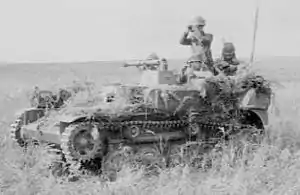Type 100 Te-Re
The Type 100 Te-Re was an artillery observation vehicle of the Imperial Japanese Army used to spot and recon for SPGs and stationary artillery. Based on the chassis of the Type 97 Te-Ke tankette, production of the vehicle began in 1940.[1] The Type 100 Te-Re was able to accommodate a crew of six to eight men, while designed to carry observation and radio equipment. A total of 100 to 150 units were produced. They were mainly used in the Second Sino-Japanese War.[2]
| Type 100 Te-Re | |
|---|---|
 Type 100 Te-Re artillery observers vehicle | |
| Type | Artillery Observation Vehicle |
| Place of origin | Empire of Japan |
| Service history | |
| In service | 1940–1945 |
| Used by | Empire of Japan |
| Wars | Second Sino-Japanese War, World War II |
| Specifications | |
| Mass | 4.9 tonnes[1] |
| Length | 4.07 meters[1] |
| Width | 1.99 meters[1] |
| Height | 1.9 meters[1] |
| Crew | 6-8[1] |
| Engine | Diesel Engine 65 hp[1] |
| Maximum speed | 40 km/h[1] |
Operation
The rear compartment was for the spotters and radio operator. Instead of being used for storing cargo or troops, this rear compartment was fitted with a large radio, observation equipment and a cable reel. Using this equipment, the spotters would find and relay targets to artillery positions. They would act as observers for the artillery fire and give firing corrections for targets, as needed.[3]
References
- Taki's Imperial Japanese Army Page: Type 100 Observation Vehicle "Te-Re" Retrieved 2016-10-13.
- Ness, Leland (2014). Guide to Japanese Ground Forces 1937-1945: Volume 2: Weapons of the Imperial Japanese Army & Navy Ground Forces. Helion & Company, pp. 270, 280. ISBN 978-19099-8275-8
- Type 100 Te-Re - D-day: wiki Retrieved 2016-10-13.